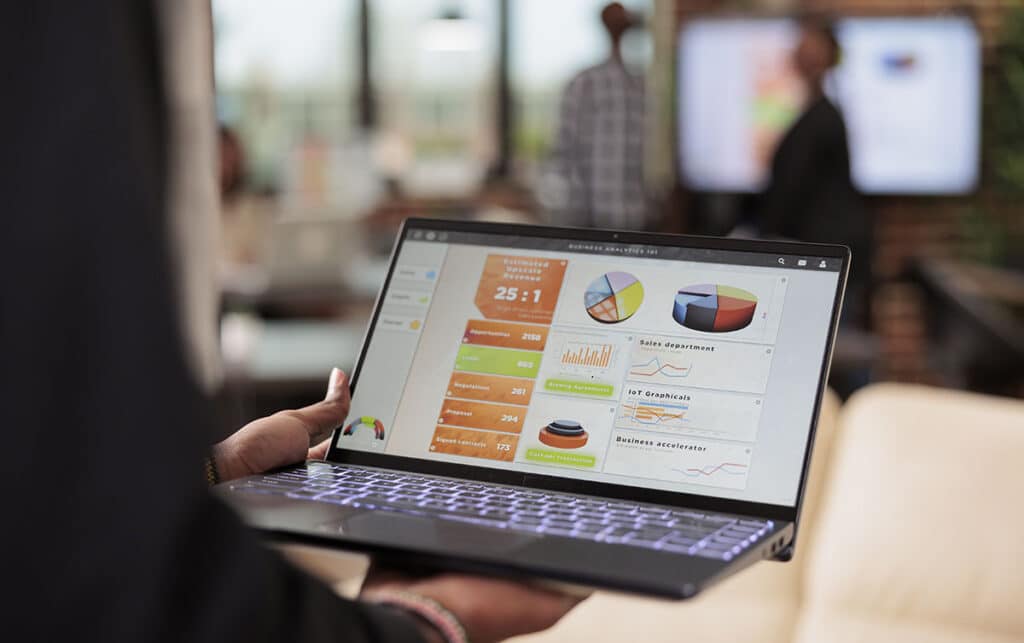Do Google Ads reign supreme in your advertising strategy? If so, that’s not too surprising. Google leads the global search market with an average share of nearly 85%, or almost nine out of every ten internet searches.1 But what about that other 15% of the global search market? The majority of it — 8.85%, to be exact2 — is allocated to Microsoft Advertising, better known as Microsoft Bing ads.
Bing is the second-most popular search engine in both the United States and the United Kingdom, generating upwards of 900 million daily searches.3 Microsoft Advertising Bing statistics show that 55% of Bing users leverage the search feature for product research and another 38% turn to Bing for brand discovery. So, Bing ads just might be the missing piece in your advertising strategy.
In today’s post, discover everything you need to know to enhance your advertising strategy with the power of Microsoft Bing ads, including:
- What Microsoft Bing ad formats are available.
- How Microsoft Bing ads compare to Google Ads.
- What to expect with Microsoft Bing ad targeting.
- How to track and measure Bing ad campaigns.
- Best practices to maximize the ROI of Bing ads.
What Microsoft Bing Ad Formats Are Available?
Microsoft Advertising, formerly known as Bing Ads, is the go-to method for advertising across the Microsoft network. Like other ad networks, Microsoft Bing ads are available in multiple formats with a variety of ad extensions that can improve performance. Each Microsoft Advertising campaign will contain one or more ad groups that can each utilize multiple keywords and ad formats.
The types of formats available for Microsoft Advertising include:
- Multimedia Ads that include large visual imagery to capture user attention.
- Dynamic Search Ads that are automatically targeted to relevant search queries.
- App Install Ads that provide a button with a direct link to download an application.
- Expanded Text Ads that allow for three description options and two headline options.
- Responsive Search Ads that mix and match up to four descriptions and 15 headline options.
- Vertical Ads that use artificial intelligence (AI) to dynamically generate high-quality placements.
- Product Ads (Bing Shopping) that instantly populate with details like imagery and price from a product catalog.
- Microsoft Audience Ads that appear on the cross-device and premium-site Microsoft Audience Network.
- Microsoft Advertising in Bing Smart Search that is formatted and displayed in the Windows 8.1 Smart Search results.
Much like other ad networks, such as Google Ads, Microsoft Advertising leverages a keyword planner to help marketers establish profitable, productive Bing campaigns. The Microsoft Keyword Planner Tool uses historical trends and marketplace competition to gauge different bids, budget levels, campaign locations, and cross-border campaigns with the highest propensity for success.
What is the Efficiency of Microsoft Bing Ads vs. Google Ads?
So, how effective are Microsoft Bing ads compared to other search engines? While it’s clear that Google dominates the global search market, there are major advantages to advertising on Bing. The primary advantage of Bing advertisements is the potential placements beyond text-based ads on the search network and graphics-based ads on the display network available through Google Ads.
Though smaller than Google as a search engine, Bing belongs to the more expansive Microsoft Advertising platform. This means that any advertisements that run through the Bing search engine also appear on search engines like DuckDuckGo and Yahoo, the third-most popular search engine.4 When considering various partner sites, Bing advertisements can reach a total of 1.5 billion users.
Not to mention, Bing search results power the popular Amazon Alexa device, which controls 69% of the smart speaker market.5 Every Microsoft and Windows 10 device and Microsoft365 subscription is also equipped with Bing as the default search engine. What does this mean for ad efficiency? Microsoft Bing ads can capture up to 63 million users that are not accessible through Google Ads.6
How Do Microsoft Bing Ads Targeting Options Stack Up?
Advertising on Bing creates an entirely new stream of leads — but how do the targeting options stack up against competitors? For one, the potential demographics may impact targeting options on Bing. Approximately 70% of Bing users are aged 35 and up and nearly 40% earn an annual household income of $100,000 or more, creating a more specific demographic to target with Bing ads.7
What targeting options are available on Microsoft Bing Ads? Unlike Google Ads, Microsoft Advertising allows for advanced geographic, device, and career targeting. With Microsoft Bing ads, marketers can target users based on their specific devices and operating systems, including the 14.7 million monthly PC searches and 653 million unique PC users on the Microsoft Search Network.8
Geographically, Microsoft Ads enable marketers to set one ad campaign to run at specific times in time zones anywhere around the globe. In comparison, Google Ads requires marketers to create separate campaigns to target users in different time zones. Microsoft Advertising even allows marketers to target an audience based on LinkedIn data, like company, industry, and job function.
How Do You Track and Measure Bing Ad Campaigns?
Marketers can track and measure the performance of their Microsoft Bing ads from the Campaigns page on their primary Microsoft Advertising hub. There, a business can export an Instant Report on a single Bing ad, ad group, or campaign performance. Each download provides a breakdown of basic campaign statistics for ads, keywords, audiences, auto targets, and dimensions in a .csv or Excel file.
It’s important to remember that any time you create multiple ads for the Bing search engine, Microsoft Advertising will evenly rotate each ad to ensure they all receive the same level of impressions. So, it may take a bit of time for each ad in your advertising campaign to receive similar impressions, drive conversions, and achieve the return on investment (ROI) you’re after.
For a more granular look at your campaign performance, opt for Expert Mode in Microsoft Advertising rather than the default Smart Mode. Smart Mode is the set-it-and-forget-it approach to Bing ads, so there’s slightly less control over campaign management. In comparison, Expert Mode enables you to access additional performance reporting, tracking, and display options.
Best Practices to Maximize Microsoft Bing Ads ROI

With multiple methods to target and track your advertisements, what are some best practices for using Microsoft Bing ads to maximize ROI? For one, be sure to experiment with as many different ad formats and targeting options applicable to your business as you can. Take advantage of the various granular targeting possibilities to create hyper-personalized advertisements for your audience.
As you explore the available options, incorporate these best practices into your ad campaigns:
- Be specific. Leverage the smaller, more niche audience on the Bing search engine and display network with clear verbiage that speaks to relevant offer details.
- Incorporate a CTA button. Multiple Microsoft ad formats include CTA buttons that are shown to positively impact both clickthrough rates and conversion rates.
- Add sitelink extensions. Similar to Google schema, Bing ads feature several sitelink extensions that take up more space in search engine results pages (SERPs).
Partner with an Agency to Get the Most Out of Bing Ads
As the global search market continues to surge, the Bing search engine continues to rise in popularity. While Microsoft Bing ads may not have the same reach as Google Ads, it’s clear that Microsoft Advertising offers marketers unrivaled benefits, such as advanced targeting options that span across geographic regions and time zones. Bing ads can reach an additional 63 million users!
So, it goes without saying that now is the time to get involved with Microsoft Bing ads. If you’re unsure where to get started, partner with a full-service digital marketing agency like Bullseye Strategy. Headquartered in Fort Lauderdale, Florida, our expansive team of digital marketing experts is ready to help you craft a powerful Microsoft Advertising strategy. Contact us today!
Sources:
1, 2. https://www.statista.com/statistics/216573/worldwide-market-share-of-search-engines/
3. https://www.oberlo.com/statistics/search-engine-market-share
4. https://www.statista.com/statistics/216573/worldwide-market-share-of-search-engines/
5. https://www.geekwire.com/2021/amazon-maintains-big-lead-google-apple-u-s-smart-speaker-market-new-study-says/
6. https://www.oberlo.com/statistics/search-engine-market-share
7. https://startupbonsai.com/microsoft-bing-statistics/
8. https://about.ads.microsoft.com/en-us/insights/planning-tools/microsoft-search-network-data







